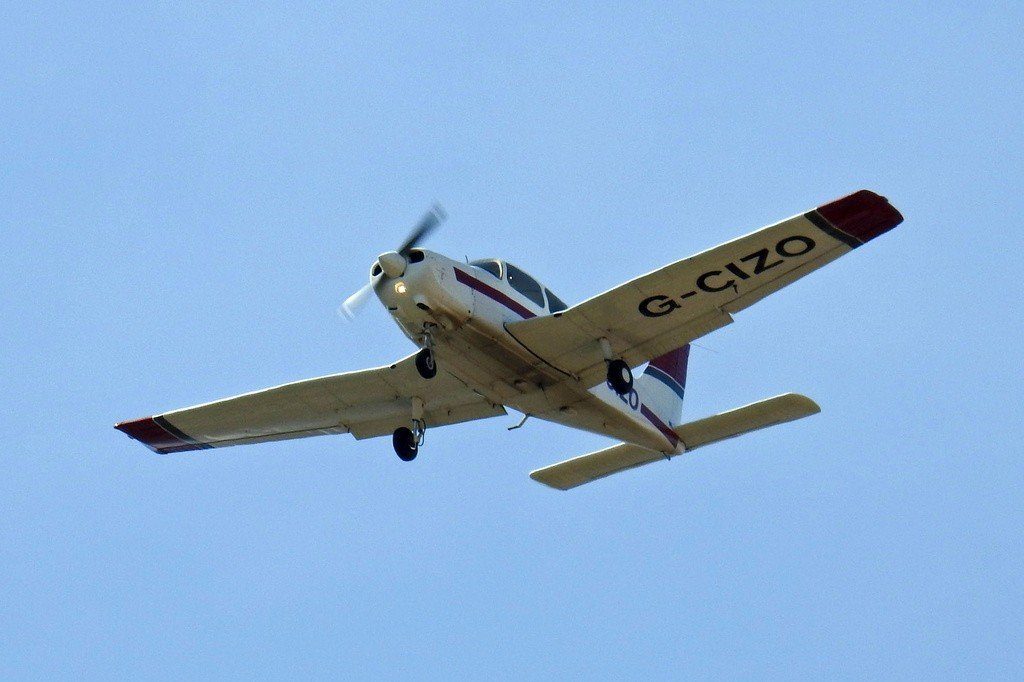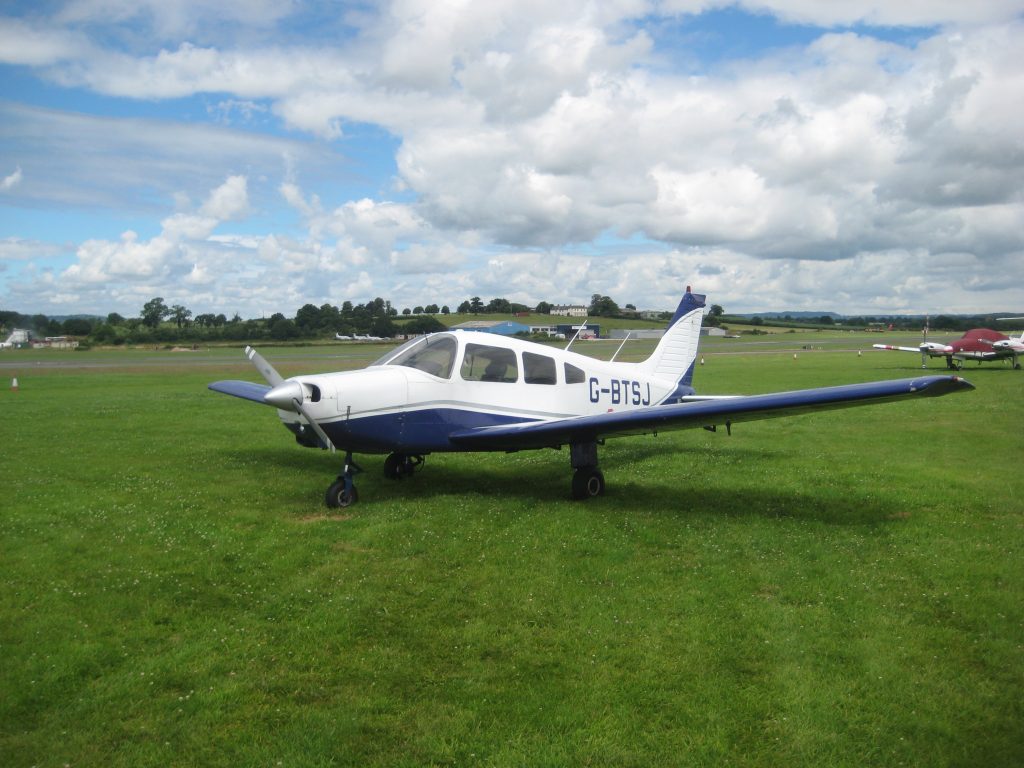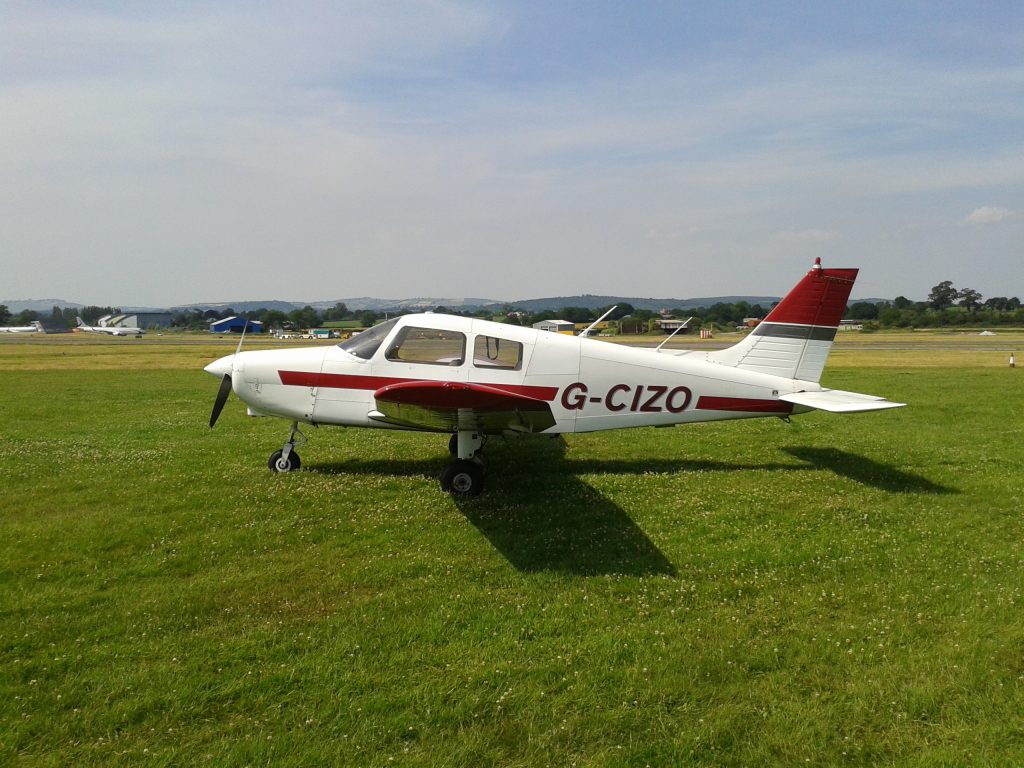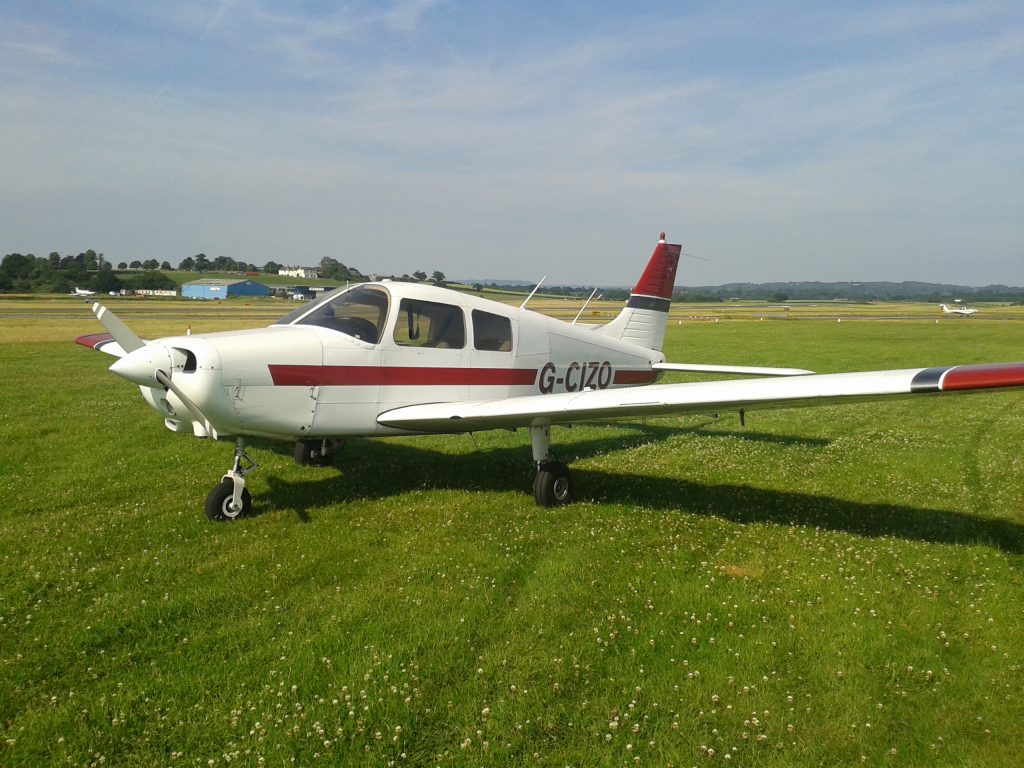Well, when I first began the Beautiful Destroyers series here on my blog, I did say that I would not always be featuring military aircraft.
If you remember, the most beautiful aeroplanes are often the ones that are designed to break things belonging to other people, hence the title ‘Beautiful Destroyers’, and I said I would also feature civilian aircraft from time to time. I’ve already featured one of my favourite civilian aeroplanes last time – the Cessna 152 – and today I am going to feature another of my favourite aeroplanes to fly – the Piper PA-28 Cherokee, also known as the ‘Warrior’. And, although she’s not a ‘Destroyer’ (although actually there are some military versions), she’s still beautiful.
The Warrior exists in various versions, and the one in the title picture, G-CIZO (‘Zulu-Oscar’), is actually a PA-28-161 ‘Cadet’, incorrectly listed in Wikipedia as being a two-seat variant. It’s not; there are definitely four seats in Zulu-Oscar! And four sets of seatbelts and four sets of headphone jacks.
And this is the aeroplane that I flew a couple of weeks ago, in order to convert back on to the Warrior after nearly sixteen years away from the type.
But that aside, the Warrior is, in my opinion, the prettiest of the light aeroplanes that I have flown. I love the double-taper wing shape; here is a lovely photo of Zulu-Oscar showing off her beautiful lines really nicely:

In the past, when I have flown a Cessna 152, it always felt as if I was putting on my second skin, so familiar am I with the aeroplane type. The aircraft very smoothly becomes an extension of me, my senses, my body, you get the picture.
And I am thrilled to have been reminded that it’s the same with the Warrior. Even after sixteen years of not flying the type, I have to say that I took to it immediately. Having completed my hour and a half conversion flight with an Instructor, five days later I took the same aeroplane up solo for a skills consolidation flight and it was just like I had never been away from the type, so delightful is this aeroplane to fly. It was like putting a glove on; she instantly becomes a part of you. She’s smooth, steady and stable, responsive and light to the touch. A real pilot’s aeroplane.
The Warrior I have flown most in the past, at Plymouth (where I learned to fly) is G-BTSJ ‘Sierra Juliet’.

Since Plymouth Airport closed a few years ago, Sierra-Juliet has lived at Newquay (where Plymouth Flying School relocated to) and I had seen her occasionally at Bodmin (where I flew after Pymouth closed) when she was there for maintenance. Now, however, she has been bought by my flying school at Exeter and I am looking forward to taking this dignified old lady up into the skies once again. She’s the aeroplane I was flying when we had the humorous ‘Forced Landing’ incident I related previously.
So, as I said, a couple of weeks ago, I flew in Zulu-Oscar, with veteran flying instructor Mike, for my type refresher conversion. Why? Well, unless you have flown it recently, you can’t really just jump into a new (to you) aircraft type and fly it, at least not safely; you need to know where all the switches are, how to handle emergencies, and especially what speeds to fly for climbing, gliding, cruise, final approach, all that sort of thing. These are what’s known as the ‘V Speeds‘. My instructor Mike is a great bloke whom I have known for most of my flying career; he was an Instructor at Plymouth just after I finished my PPL and he’s patient, unflappable and great to work with. So off we toddled up towards Cullompton and Wellington, two towns to the north of Exeter, for General Handling practice including steep turns, stalls and a PFL. Then across the moor to the busy local General Aviation (GA) aerodrome at Dunkeswell for circuits and touch-and-go landing practice. Because Dunkeswell were using their shorter Runway 17, I had to relearn very quickly about the Warrior’s acceleration/deceleration characteristics. The PA-28 is a very slippery aeroplane and, while she accelerates readily, slowing down is really not that easy. And so I had to fly four circuits of precision flying, controlling height, heading and speed accurately as well as communicating with the ground radio people, keeping a lookout and maintaining high situational awareness because of the busy circuit traffic at Dunkeswell that day. My first landing was admittedly more of a controlled crash; after raising the nose for the flare (just before landing), my airspeed fell off a little too quickly and I came down like it was on an aircraft carrier. Boomps-a-daisy. And to cap it all, on our last final approach, they decided to chuck a load of parachutists out over the airfield and they were coming down all over the place. But they kept to their area of the airfield and away from the active runway, so all was well, although Mike did double-check with the ground people to make sure they were happy with us continuing our approach (they were). So, a quick full-stop landing for refuelling, then it’s off to Exeter again, land there, get my logbook signed to say I’d requalified on the Warrior and the job’s a good ‘un.
Here’s a profile view of Zulu-Oscar:
Look at those lovely, clean lines and the beautiful curves on the tailfin. Also worthy of note is the ‘slab tailplane’. The entire tailplane – that’s the small wing-like structure at the back end – is what’s known as an ‘all-flying tailplane’, ‘stabilator‘, or ‘slab tailplane’. What this means is that, instead of the tailplane being fixed but with separate moving surfaces (known as ‘elevators’) as the part of the tailplane that controls the ‘attitude’ or ‘pitch’ (nose-up/nose-down) of the aeroplane, instead, with a slab tailplane, the entire tailplane moves as a single piece to provide this control. Because the slab tailplane has such a large area when compared to normal elevators, this means that this sort of tailplane confers excellent ‘pitch authority’, in that the aeroplane responds decisively and enthusiastically to pitch control inputs. This gives a very ‘positive’, yet also very light, feel to the controls when flying this type. In addition, unlike the Piper PA-38 ‘Tomahawk’ that I also fly, which has a high ‘T’-tailplane, the lower tailplane on the Warrior sits in the propeller slipstream – the ‘wash’ of high-speed air blown backwards along the aeroplane by the propeller – and this gives it even more pitch authority. Because of this, it’s virtually impossible for the tailplane to enter a dangerous ‘deep stall‘ condition, which makes for a much safer aeroplane.
So, there we go, that’s the Piper Warrior. I’ve not given much detail on performance or stuff like that, but instead a proper ‘pilot’s-eye’ view of a lovely aeroplane which flies as nicely as it looks. Here’s a final shot of Zulu-Oscar, taken just after my consolidation flight last week:


